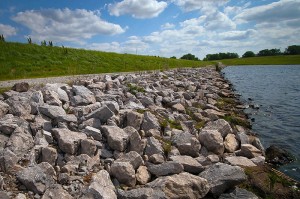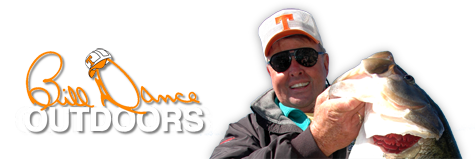How To Target A Bass Angler’s Favorite Target-Riprap
Posted: July 30th, 2014 by Bill Dance
If you think riprap are those undesirable people you want thrown out of a party, or maybe even an occurrence where a hip-hopster split his pants, well, you’re probably not a fisherman.
In fact, you are probably considered riff-raff to anglers, because you don’t fit in. That’s OK, I’m here to help.
 Bass fishermen know that riprap most definitely as a target that needs to be fished. But according to UG (that’s University of Google, not University of Georgia, though they might tell you the same thing) riprap is: is basically rock or other material to armor shorelines, streambeds, bridge abutments, pilings and other shoreline structures against scour-, water- or ice erosion. Some also refer to it as shot rock, rock armor or even rubble (the latter not named after Barney).
Bass fishermen know that riprap most definitely as a target that needs to be fished. But according to UG (that’s University of Google, not University of Georgia, though they might tell you the same thing) riprap is: is basically rock or other material to armor shorelines, streambeds, bridge abutments, pilings and other shoreline structures against scour-, water- or ice erosion. Some also refer to it as shot rock, rock armor or even rubble (the latter not named after Barney).
It is made from a variety of rock types, but most commonly it will be granite or limestone. Occasionally, resourceful people will recycle rubble from building or paving demolition. And again, according to UG, it can be used on any waterway or water containment where there is potential for water erosion.
Quite simply, riprap helps hold soil in place and fights erosion. You are likely to see it anywhere, off the side of an interstate, along a canal, or under a bridge. Of course, it is much more common in regions where soil types are more susceptible to soil erosion.
And like I said anglers love to see it. Riprap is a target of opportunity for the bass fisherman. It’s great cover, and it attracts fish for obvious reasons. Bait is found there. The submerged portions cover with algae and create something of a food chain. Prey is also attracted to the rocky terrain it creates because it can provide places to hide. In turn, predator fish like bass follow.
Riprap can also absorb from the sun, and even provide better fishing opportunities on days the temps are cold. The water can actually be a few degrees warmer closer to the sun-soaked rocks.
Of course, there are miles of it in many waterways. So the question may be, what makes some more productive than others? Where should you concentrate your efforts?
Fishing along riprap can be very rewarding and the key is to fish the irregular features.
Riprap may look the same above the surface, but it’s what’s underneath the surface that counts.
Search for submerged logs, underwater points, rock slides, terrain changes, rock piles, ditches or channels that swing in close to the bank. A good graph unit can help you find these high-percentage areas where you’re sure to have better success, especially for concentrations of bass.
A stretch of riprap can produce almost year round in areas with weather and conditions like Florida, but early in the year, February through April is usually best. Fishing is good then because warming water causes algae to bloom (not earlier mention of algae-covered riprap). As algae grows, bait fish are attracted to this food source. Where you find baitfish, naturally, bass won’t be far away.
See ya next time!

